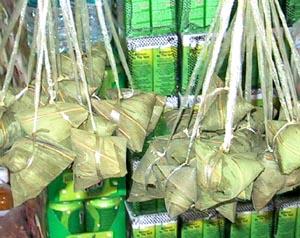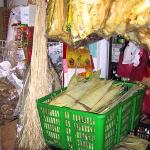Feeding the dragons
In the weeks leading to the 5th day of the 5th lunar month, some unusual items start appearing on the shelves of supermarkets and provision shops. Piles of dried bamboo leaves, tied up in bundles. An abundance of dried chestnuts, hard and wrinkled, shells removed, with bits of brown skin still stuck on them. Dried mushrooms and shrimps heaped high in open boxes. All with their distinctive aromas.
The 5th day of the 5th lunar month is the anniversary of the death of Qu Yuan, a wise and learned Chinese patriot and poet who lived in the Kingdom of Chu during the Warring States. His ability at reform antagonized other court officials, who influenced the weak-willed king to dismiss and exile Qu Yuan. During the next 20 years, he traveled extensively, and put into verse what he saw and thought. Disheartened by the progressive occupation of Chu land by the State of Qin, he finally threw himself into the Mi Luo River on the 5th day of the 5th lunar month.
When fishermen heard of his suicide, they set forth in boats to look for him. Thus began the tradition of having dragon boat races at this annual festival. Legend has it that when Qu Yuan's body could not be found, his admirers threw rice wrapped in bamboo leaves into the river so that the sea creatures would spare the patriot's body.
The origins of this festival may have been something learned by the average Singaporean in school and long since relegated to obscure recesses of the mind, but rice dumplings are still consumed in large quantities, especially at this time of the year.
Like many festive favorites, rice dumplings are also available throughout the year. They are sold at hawker stalls that sell breakfast food, together with the fried rice noodles, steamed rice sheets ("chee cheong fun"), steamed yam-and-rice-flour cakes and steamed rice cakes. But it is during the weeks leading up to the actual festival that shops, restaurants and homemakers go all out to produce large quantities and varieties of dumplings, as festive food take on a special character when consumed during the festival.
There are two basic types of dumplings: the savory dumplings made with glutinous rice and different kinds of (usually meat) fillings, and the sweet dumplings made with glutinous rice which has been soaked in alkaline water. And then, of course, there are the myriad variations of the two.
For the savory dumplings, the rice is soaked for 2 hours and then the drained rice grains fried and flavored. Each family or shop has its own special recipe. Some fry the glutinous rice in garlic, others mix beans into the rice. Some prefer the rice to be white in colour, others are liberal with the dark soya sauce that yields a dark brown coloring after cooking.
The Peranakan (Straits Chinese) add cow-pea flowers into the rice, which lend a delicate taste and pretty splotches of blue in the white cooked rice. Pork with enough fat so as not to taste dry and stringy after hours of boiling, mushrooms, dried sugar-coated winter melon, are cut into tiny cubes. Thanks to the sweet winter melon, these dumplings are sweet-savory in flavor. The Peranakans use large pandan leaves that are up to 5 ft in length, trimmed to size, to wrap the dumplings, instead of the traditional bamboo leaves. Rice dumplings boiled for several hours in these fragrant leaves take on their sweet aroma, which blend with the pungent coriander powder dashed generously when frying the filling.
For the Fujian-style dumplings, the meat and mushrooms are cut into larger pieces. The meat, mushrooms, chestnuts and dried shrimps are fried and seasoned with dark soya sauce, the 5-spices mix (star anise, Szechuan peppercorn, fennel, clove and cinnamon) and sat. While wrapping the dumplings, one picks the filling, piece by piece. Several pieces of pork, two chestnuts, three pieces of mushroom, some dried shrimps and so on. With the Peranakan-style dumplings, the ingredients of the filling have been cut into such small pieces and thoroughly mixed while frying that it is simply scooped by the spoonful.
The preparation of rice dumplings starts weeks before the actual festival. Before the festival, someone walking down the corridor of a public housing apartment block may wonder why so many housewives sitting at the dining table are staring intently at piles of rice and moving some grains this way or the other. For making the sweet dumplings, the glutinous rice has to be sorted by hand, grain by grain, to remove those grains which are translucent, ensuring that only the opaque glutinous rice is used. Sweet dumplings should have a characteristic chewy texture, and normal rice would mar this.
Some people put red bean paste as a filling in the sweet dumplings. To make the paste, the red beans have to be soaked, boiled, with some pieces of orange rind added for a tangy flavor. The mixture is then pressed through a sieve to remove the husks. The smooth paste is fried in oil in a wok, and sugar added to yield a thick, dark brown paste. It doesn't look terribly exciting but glides down the throat in a trail of taste sensations blending the sweet, nutty flavor of the red beans with a tinge of citrus smoothened by the oil. This too, has to be prepared in advance, and stored in the refrigerator.
The day before making the sweet dumplings, alkaline crystals are dissolved in water, and the alkaline water added to the rice, mixed well with the sorted rice grains and left to soak overnight. The alkaline water gives the rice a pale yellow color, which turns golden yellow after cooking.
The dry bamboo leaves have to be scalded in hot water, soaked overnight and washed so that they are soft enough to be folded without splitting. This involves cleaning both sides of each leaf with a wash-cloth, and at the same time sorting out any leaves which are torn or have holes in them. The more fastidious would also trim off both ends of the leaves for neatness.
The strings traditionally used to tie the dumplings are made from the bark of the banana tree, split into strips and dried. These can be purchased in bunches, twisted into a knotted loop. The bunches of string are hung by the loop from hooks while the dumplings are wrapped. However, these have increasingly given way to synthetic raffia which is cheaper and sturdier. The raffia strings are easier to split into strips of even width, whereas the banana bark often tapers off during splitting, according to the grain of the plant, rendering them too thin and liable to burst during tying. The strings, too, have to be soaked overnight to soften and prevent breakage while tying.
The actual wrapping of the dumplings is a social affair. Usually, several family members get together to help each other with their dumpling preparation for the year, moving from house to house during the week prior to the festival. A bunch of the string is hung from a hook suspended from the ceiling. The bamboo leaves are not all of the same size. Each person gauges the size of the leaf. If it is too small, it will be necessary to take two leaves and overlap them to that they are broad and long enough to make a dumpling of average size. Holding the middle of the leaf with both hands, the leaf is folded so that a cone is formed. Holding the cone in place with one hand, some of the rice is scooped to half-fill the cone. Then a spoonful of red bean paste is dropped into the rice. The paste should not be moved once it has been dropped into the rice, as this may cause rice grains to be mixed into the bean paste, away from the outer layer which comes into contact with the boiling water. Rice grains that are embedded within the bean paste will not be properly cooked. The ends of the leaf are then folded to cover the case, and twisted neatly to one side. Holding on to the dumpling with one hand to retain the folds, a piece of string is grabbed from the hanging bunch, and twisted twice round the dumpling before a knot is tied.
Even though the wrapping of the dumplings seems like an easy enough task, only those who have tasted the final product will understand the feel that is required to made a good dumpling. Only with practice can one estimate how much rice to put into the cone, so that the dumpling is of the right consistency. Stuffing too much rice into the case will result in a dumpling that is too hard, as the rice expands after boiling and fills out the case to bursting. The dumpling tends to be rounded like a ball, with a deep crease where the string has been tied around the leaf, and will be hard to bite into. Too little rice in the case will make it extremely difficult to fold the leaf into a neat case. If it is too loose, the string will again cut into the dumpling once it is tightened. Too little rice, and you will not get nice, pointed corners in the dumpling. Worse yet, the whole case could come apart during boiling, scattering the rice into the water and turning the boiling water into a thick, gooey mess. After enough practice, the experts know just how much rice to put in to fill the case right up to the corners after boiling, that will yield a dumpling that is "al dente" while having a nice shape.
The savory dumplings require even more preparatory work. All the dry ingredients - mushrooms, chestnuts, shrimps, have to be soaked in hot water. The mushrooms are then diced or quartered, depending on the type of dumpling being made. The chestnuts are cleaned by removing the bits of brown skin, softened after the soaking, with tweezers or toothpicks. Lean pork is cut into pieces, while fatty pork is first boiled before cutting. Shallots are peeled and sliced, garlic chopped, sugared winter melon diced. The whole array of ingredients stands in bowls and trays around the wok waiting to be unified.
The wok is heated and cooking oil added. Into the hot oil goes the whole pile of sliced shallots, which are gently stirred until they turn golden brown. The deep-fried shallots are removed, and into the oil goes the garlic, and then in succession, the pork, mushrooms, chestnuts, shrimps or winter melon. Soya sauce, salt, pepper, and coriander or 5-spice powder (a mix of cinnamon, cloves, fennel, star anise and pepper) are added. The whole kitchen fills with the heady fragrance of so many spices and cooking aromas, driving the nose crazy. The filling is left to cool, and then stored in the refrigerator. For the Peranakan-style dumplings, the deep-fried shallots are mixed with the cooked ingredients just before they are used.
On the day itself, the glutinous rice is soaked for about 2 hours, drained, fried and seasoned. Then the actual making can begin, pretty much as for the sweet dumplings. Some rice in the cone, generous amounts of fillings, covered with more rice. Meanwhile, a large pot of water is set to boil, and salt added. After the dumplings have been wrapped, they are transferred in bunches into the pot, and boiled for about 3 hours (sweet dumplings for 2 1/2 hours).
Dumpling-making, like all cooking, offers lots of room for creativity and new variations. The old wisdom that anything made with good ingredients will taste good holds true. The fillings have been made with chicken instead of pork, scallops, Chinese sausages, salted egg yolks.... The possibilities are endless.
And after all the hard work, the industrious ladies are pleased to be able to exchange dumplings among friends and relatives, enjoying the different versions that each family has made. Those who are too busy to make the dumplings themselves would buy them from shops and restaurants, and offer them as gifts, or for their own consumption. Most families make it a point to have dumplings on the 5th day of the 5th lunar month. Those who practise ancestral worship offer rice dumplings to their ancestors. For others, it may just be a time for the family to gather together and enjoy the dumplings, washed down with Chinese tea, while exchanging banter on which family member holds the record for consuming the most rice dumplings over the years.
Some may actually remember the origins of the festival and reflect for a moment on patriotism, the importance of loyalty and commitment to the community. To most people nowadays, the festival is just about enjoying the delicious dumplings, the taste heightened by the knowledge of the amount of work that went into making each dumpling, such an expenditure of time and labor that is such a luxury in the modern world. And wondering if the next generation will ever want to bother to learn the art of making rice dumplings. But as long as the demand is there, at least those willing to pay for it know that there will be enough shops churning out those dumplings for a while.
* * * * *
 ThingsAsian
ThingsAsian




















